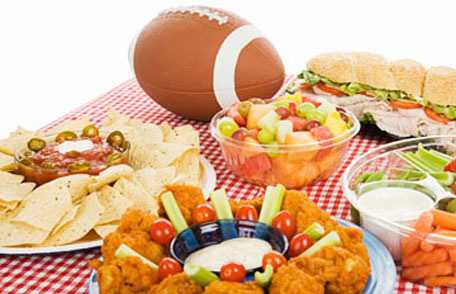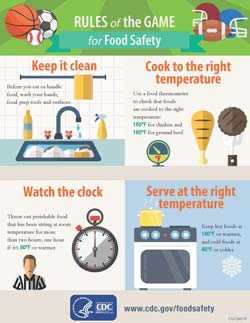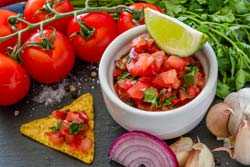Game Day Food Safety Tips
 Tackling a buffet at your Super Bowl gathering? Practice these game rules and keep the runs on the field.
Tackling a buffet at your Super Bowl gathering? Practice these game rules and keep the runs on the field.
Super Bowl Sunday is an American tradition of football, friends, and food. It’s the second largest food consumption day of the year, ranking only behind Thanksgiving.
Make sure your Super Bowl gathering is memorable for all the right reasons! Follow these six tips to avoid food poisoning:
1. Keep it clean.
- Wash your hands with soap and running water (warm or cold) for at least 20 seconds before preparing, eating, and handling food—especially after passing the TV’s germy remote control! Also wash your hands after using the bathroom and touching pets.
- Wash your cutting boards, dishes, utensils, and countertops with hot, soapy water after preparing each food item.
- Rinse produce under running water, including those with inedible skins and rinds. For firm-skin fruits and vegetables, rub by hand or scrub with a clean vegetable brush while rinsing.
2. Cook it well.
- Use a food thermometer to test Super Bowl party favorites, like chicken wings and ground beef sliders, and any other meat or microwaved dishes on your menu.
- Make sure chicken wings (and any other poultry) reach a minimum internal temperature of 165°F and that any ground beef sliders or burgers reach 160°F.
- Microwave leftovers to 165°F to get rid of harmful bacteria.
- Refer to the Safe Minimum Cooking Temperatures chart for the “rest time” of meats—the period after cooking that some meats need to rest before serving to ensure that germs are killed.
- Good news for your super-hungry guests: chicken wings and ground beef sliders don’t require rest times!

Rules of the Game for Food Safety
View larger image and text description
3. Keep it safe.
- If preparing food in advance, divide cooked food into shallow containers and store in a refrigerator or freezer until the party begins. This encourages rapid, even cooling…and discourages pre-party nibblers.
- Getting takeout or delivery? [228 KB] Make sure to keep hot foods hot, and cold foods cold.
- Hold hot foods at 140°F or warmer. Use chafing dishes, slow cookers, and warming trays to keep food hot on the buffet table.
- Maintain cold foods, like salsa and guacamole, at 40°F or colder. Use small service trays or nest serving dishes in bowls of ice, replacing ice often.
- Large pots of food, such as soups or stews, and large cuts of meats, such as roasts or whole poultry, should be divided into small quantities for refrigeration to allow them to cool quickly and minimize time in the temperature “danger zone” between 40°F and 140°F.
4. Watch the time.
- Follow recommended microwave cooking and standing times.
- “Cold spots”—areas that are not completely cooked—can harbor germs.
- Always follow directions for the “standing time,” the extra minutes that food should stand in the microwave to complete the cooking process. Then check the internal temperature with a food thermometer.
- Track the time that food stays on the buffet.
- Sideline any perishable foods that have been out at room temperature for two hours or more.
5. Avoid mix-ups.
- Separate raw meats from ready-to-eat foods like veggies when preparing, serving, or storing foods.
- Offer guests serving utensils and small plates to discourage them from eating directly from the bowls with dips and salsa.
6. Get it to-go.
- Discard [228 KB] any perishable foods on the buffet for two hours or more.
- Divide leftovers into smaller portions or pieces, place in shallow containers, and refrigerate.
- Leftover foods should be refrigerated at 40°F or below as soon as possible and within two hours of preparation. It’s OK to put hot foods directly into the refrigerator.
- Refrigerate leftovers for three to four days at most. Freeze them if you won’t be eating the leftovers sooner.
- Leftovers should be reheated to at least 165°F (74°C) before serving.
A Recipe for Fresh Salsa—Remember to Refrigerate!
Serving salsa on game day? Try this winning recipe for fresh salsa that uses fresh garlic and fresh lime juice to protect against Salmonella. Remember to refrigerate the salsa until it’s time to serve. Nest the bowl in ice once it’s on the serving table or make sure you follow the two-hour rule.

Ingredients
18 fresh Roma tomatoes
1 medium jalapeño pepper, stem removed
1 small Vidalia onion, peeled
4 tablespoons fresh cilantro leaves
1 ½ teaspoons salt
2 tablespoons fresh garlic
2 ounces fresh lime juice
Directions
- Wash your hands and clean the cutting board and prep area with soap and water.
- Rinse the tomatoes, jalapeño pepper, and cilantro under running water.
- Chop the tomatoes into small pieces.
- Finely dice the onion, jalapeño pepper, and garlic.
- Chop the cilantro leaves into small pieces.
- Combine tomatoes, peppers, onion, cilantro, salt, garlic and lime juice in a bowl and refrigerate until serving time.
- Enjoy!
More Information
- Page last reviewed: February 1, 2017
- Page last updated: February 1, 2017
- Content source:
- National Center for Emerging and Zoonotic Infectious Diseases, Division of Foodborne, Waterborne, and Environmental Diseases
- Page maintained by: Office of the Associate Director for Communication, Digital Media Branch, Division of Public Affairs




 ShareCompartir
ShareCompartir